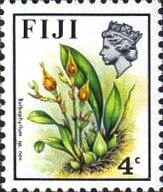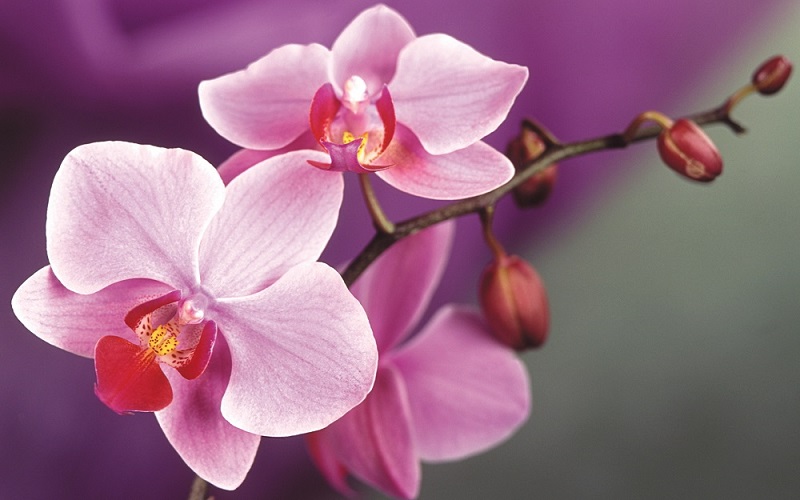Stamp: Bulbophyllum sp. (Fiji 1976)
Bulbophyllum sp. (Fiji 1976)
03 September (Fiji ) within release Birds and Flowers Definitives 1975 - 1977 goes into circulation Stamp Bulbophyllum sp. face value 4 Fijian cent
| Stamp Bulbophyllum sp. in catalogues | |
|---|---|
| Stamp Number: | Sn: FJ 308b |
| Stanley Gibbons: | Sg: FJ 508 |
Stamp is vertical format.
Also in the issue Birds and Flowers Definitives 1975 - 1977:
- Stamp - Blue-crested Broadbill (Myiagra azureocapilla) face value 8;
- Stamp - Bulbophyllum sp. face value 4;
- Stamp - Collared Lory (Phigys solitarius) face value 1;
- Stamp - Dendrobium gordonii face value 30;
- Stamp - Dendrobium platygastrium face value 2;
- Stamp - Dendrobium tokai face value 15;
- Stamp - Phaius tankervilleae face value 6;
- Stamp - Yellow-breasted Musk Parrot (Prosopeia personata) face value 40;
- Stamp - Yellow-breasted Musk Parrot (Prosopeia personata) face value 40;
- Stamp - Yellow-breasted Musk Parrot (Prosopeia personata) face value 50;
Stamp Bulbophyllum sp. it reflects the thematic directions:
A flower, sometimes known as a bloom or blossom, is the reproductive structure found in plants that are floral (plants of the division Magnoliophyta, also called angiosperms). The biological function of a flower is to effect reproduction, usually by providing a mechanism for the union of sperm with eggs. Flowers may facilitate outcrossing (fusion of sperm and eggs from different individuals in a population) or allow selfing (fusion of sperm and egg from the same flower). Some flowers produce diaspores without fertilization (parthenocarpy). Flowers contain sporangia and are the site where gametophytes develop. Many flowers have evolved to be attractive to animals, so as to cause them to be vectors for the transfer of pollen. After fertilization, the ovary of the flower develops into fruit containing seeds. In addition to facilitating the reproduction of flowering plants, flowers have long been admired and used by humans to beautify their environment, and also as objects of romance, ritual, religion, medicine and as a source of food.
The Orchidaceae are a diverse and widespread family of flowering plants, with blooms that are often colourful and often fragrant, commonly known as the orchid family. Along with the Asteraceae, they are one of the two largest families of flowering plants. The Orchidaceae have about 28,000 currently accepted species, distributed in about 763 genera. The determination of which family is larger is still under debate, because verified data on the members of such enormous families are continually in flux. Regardless, the number of orchid species nearly equals the number of bony fishes and is more than twice the number of bird species, and about four times the number of mammal species. The family also encompasses about 6–11% of all seed plants. The largest genera are Bulbophyllum (2,000 species), Epidendrum (1,500 species), Dendrobium (1,400 species) and Pleurothallis (1,000 species). The family also includes Vanilla (the genus of the vanilla plant), Orchis (type genus), and many commonly cultivated plants such as Phalaenopsis and Cattleya. Moreover, since the introduction of tropical species into cultivation in the 19th century, horticulturists have produced more than 100,000 hybrids and cultivars.
Flora is the plant life occurring in a particular region or time, generally the naturally occurring or indigenous—native plant life. The corresponding term for animal life is fauna. Flora, fauna and other forms of life such as fungi are collectively referred to as biota. Sometimes bacteria and fungi are also referred to as flora, as in the terms gut flora or skin flora.
Queen - the title of reigning female monarch or the wife of the king in a number of countries
A Royalty is the immediate family of a king or queen regnant, and sometimes his or her extended family. The term imperial family appropriately describes the family of an emperor or empress, and the term papal family describes the family of a pope, while the terms baronial family, comital family, ducal family, grand ducal family, or princely family are more appropriate to describe the relatives of a reigning baron, count, duke, grand duke, or prince. However, in common parlance members of any family which reigns by hereditary right are often referred to as royalty or "royals." It is also customary in some circles to refer to the extended relations of a deposed monarch and his or her descendants as a royal family. A dynasty is sometimes referred to as "the House of ...". As of July 2013, there are 26 active sovereign monarchies in the world who rule or reign over 43 countries in all





